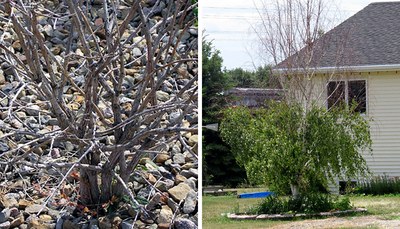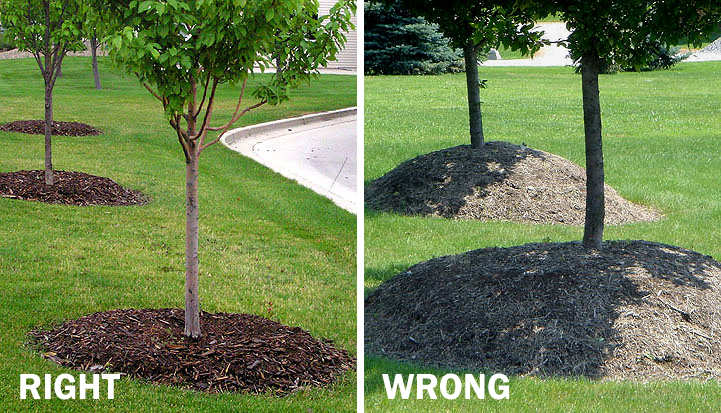Choosing Mulch For Trees and Shrubs
Do you enjoy torturing plants? If yes, get some rock mulch and put it around your plants.
Rock mulch does nothing for a plant. A rocky bed may look good to us, but the plants are crying in pain.
Use shredded bark instead. It’s better for many reasons:

- Shredded bark will moderate temperatures. It will keep a plant cooler during summer and warmer during winter. Perfect! Rock mulch is a heat trap. It will scorch plants during the summer and make plants uncomfortable in winter, too. For heat-sensitive plants like birch, mountain ash and hosta, the use of rock mulch may contribute to premature death.
- Shredded bark improves the soil. It enhances soil structure, leading to an aerated soil that can hold onto nutrients and moisture. Although there can be a short-term loss of nitrogen, the bark will eventually compensate for this and add more nutrients. Rock mulch harms the soil. Its heavy weight compacts the ground and destroys air pockets needed for roots to grow. Also, rocks add no nutrients to the soil.
- Both mulch types protect plants from lawn mowers, but the jagged edges of rock mulch can cause harm on tender bark.
- Both mulch types conserve moisture, but the heat generated from rock mulch creates greater drought stress on the plants.
Rock mulch is terrible for plants—so why do we use it?
Some gardeners worry about weeds growing in shredded bark. True, shredded bark will allow more weeds compared to a barrier of jagged rocks and landscape fabric. However, weeds in shredded bark are sparse and pull out easily. A spray of Roundup once a year may be applied to control tough weeds like quackgrass.
Some gardeners are frustrated that shredded bark can blow away. Rarely is this a significant problem if the mulch is applied properly:

- Shredded bark should be applied in a circle at least three feet wide; the wider the better. Take the mulch all the way out to the dripline, if you want. The mulch should be minimal at the trunk and gradually increase in depth to three to four inches around the perimeter.
- Do not heap mulch around the trunk—these “volcano” mulch piles harm the tree by causing trunk rot and encouraging mice to nest near the trunk.
The next time you plant a tree or shrub, show it some love and surround it with shredded bark. You will be rewarded with a happy, healthy plant.
Revised from an article published in the NDSU Yard & Garden Report of August 16, 2013.
Written by Tom Kalb, Extension Horticulturist, North Dakota State University. Published in the NDSU Yard & Garden Report, June 30, 2016. Photos were made available under Creative Commons licenses specified by the photographers: Tom Kalb, NDSU; eXtension.org: Gardens, Lawns, and Landscapes